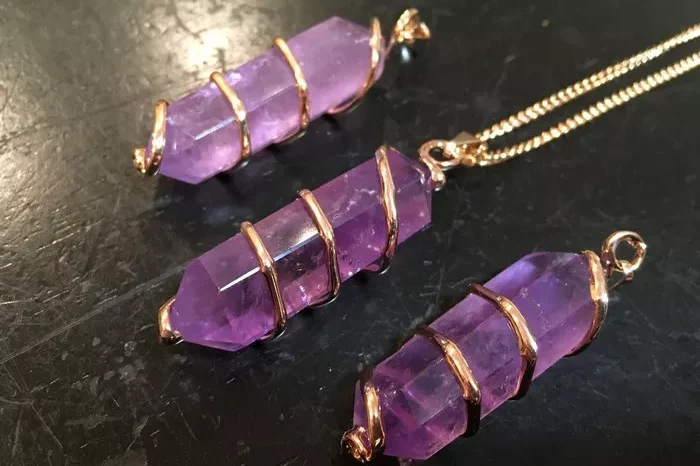Jewelry appraisal is a complex process that involves various factors to determine the true value of a piece. This is particularly true for gemstone jewelry, such as amethyst necklaces, which have unique characteristics and varying qualities. This guide aims to provide a comprehensive understanding of how to assess the value of an amethyst necklace, broken down into various aspects that influence pricing.
Understanding Amethyst
1. What is Amethyst?
Amethyst is a variety of quartz that displays a vibrant purple hue. This color is caused by trace amounts of iron and other impurities within the quartz crystal structure. It is a semiprecious gemstone that has been cherished for its beauty and mystical properties for thousands of years.
2. Properties of Amethyst
Color: The most notable feature of amethyst is its purple color, which can range from light lavender to deep, rich purple. The intensity and saturation of the color play a significant role in determining the gemstone’s value.
Clarity: Like other gemstones, amethyst can exhibit varying degrees of clarity. Stones with fewer inclusions and better transparency are generally more valuable.
Cut: The quality of the cut can enhance or detract from the gemstone’s appearance. A well-cut amethyst will display excellent brilliance and light reflection.
Carat Weight: Larger gemstones are typically more valuable, as they are rarer and more difficult to find.
Factors Influencing the Value of an Amethyst Necklace
1. Quality of the Gemstones
Color Intensity: As mentioned, the intensity of the purple color is crucial. Deeper, more saturated purples are generally preferred and therefore more valuable.
Clarity: Gemstones with fewer internal flaws or inclusions are more transparent and therefore more valuable. Amethyst can sometimes have natural cracks or white streaks within, which can reduce its clarity and, consequently, its value.
Cut: A well-cut amethyst will maximize its brilliance and light reflection. Poorly cut stones may appear dull or lifeless.
Carat Weight: Larger amethyst gemstones are rarer and thus command a higher price.
2. Design and Craftsmanship
Complexity of Design: Intricate designs often require more skill and time to create, which can increase the overall value of the necklace.
Metal Used: The metal setting can also impact the price. Precious metals like gold or platinum add to the necklace’s value, while base metals like silver or brass may be less expensive.
Clasp and Chain Quality: The quality of the clasp and chain should also be considered. A sturdy, well-made clasp ensures the necklace is secure and comfortable to wear, while a high-quality chain adds to the durability and overall appeal.
3. Provenance and Brand
Historical Significance: If the amethyst necklace has a historical significance or is associated with a famous person or event, it can significantly increase its value.
Brand or Designer: Pieces created by well-known designers or brands often have a higher price due to the cachet associated with the name.
4. Market Demand and Supply
Popularity: The popularity of amethyst and gemstone jewelry in general can affect the market demand. High demand can drive up prices, while low demand may result in discounts.
Scarcity: The rarity of high-quality amethyst gemstones can also influence pricing. As with many gemstones, the more scarce a high-quality example becomes, the higher its value.
Steps to Assess the Value of an Amethyst Necklace
1. Conduct a Thorough Inspection
Begin by visually inspecting the necklace. Examine the gemstones for color intensity, clarity, and any visible flaws or inclusions. Check the metal setting for signs of wear or damage. Pay attention to the design and craftsmanship, noting any intricate details or unique features.
2. Measure the Gemstones
Use calipers to measure the dimensions of each gemstone, including its diameter and depth. Record these measurements accurately as they will be used to calculate the carat weight and assess the size of the stones.
3. Evaluate the Cut
Assess the quality of the cut by observing how the light reflects off the gemstones. A well-cut amethyst will display excellent brilliance and sparkle, while a poorly cut stone may appear dull or lifeless.
4. Determine the Metal Type and Quality
Identify the metal used in the setting and evaluate its quality. Precious metals like gold and platinum are more valuable than base metals like silver or brass. Check for hallmarks or stamps that indicate the metal content and purity.
5. Consider Provenance and Brand
Research the history of the necklace and any associations it may have with famous individuals or events. Determine if the necklace is a piece by a well-known designer or brand, as this can significantly impact its value.
6. Compare with Market Prices
Research current market prices for similar amethyst necklaces. Look for pieces with similar qualities, designs, and metal settings. This will help you establish a fair market value for your necklace.
7. Consider Additional Factors
Take into account any additional factors that may affect the necklace’s value, such as sentimental value, condition, and any unique features or modifications. These factors can sometimes make a significant difference in the final appraisal price.
Conclusion
Assessing the value of an amethyst necklace is a multi-faceted process that involves evaluating various factors, including gemstone quality, design and craftsmanship, provenance and brand, and market demand and supply. By conducting a thorough inspection, measuring the gemstones, evaluating the cut, determining the metal type and quality, researching provenance and brand, comparing with market prices, and considering additional factors, you can establish a fair and accurate appraisal value for your amethyst necklace.
Related topic:


